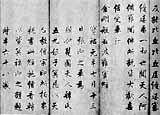Vajrasekhara Sutra
Jump to navigation
Jump to search
| Chinese canon |
|---|
| Mainstream texts |
| Mahayana sutras |
|
| Tantras |
|
The Vajraśekhara Sūtra is a tantric text that is included in both the Chinese Canon and the Tibetan Canon.
The title of the text is derived from the first chapter of the Sarvatathāgatatattvasaṃgraha, translated by Vajrabodhi and Amoghavajra during the Tang dynasty.[1] "The full text of the Sarvatathāgatatattvasaṃgraha was not translated into Chinese until Dānapāla completed his version in 1015 CE."[1]
The Chinese Canon also includes a number of ritual texts and commentaries with the same title.[1]
The Vajraśekhara Sūtra is a composite text of 18 texts; the original texts are said to have been lost.[1]
A Tibetan text entitled Vajraśekhara Tantra is an explanatory yoga tantra connected to the Sarvatathāgatatattvasaṃgraha.[1][2]
References
- ↑ 1.0 1.1 1.2 1.3 1.4 Robert E. Buswell Jr., Donald S. Lopez Jr., The Princeton Dictionary of Buddhism (Princeton: 2014), s.v. Vajraśekharasūtra
- ↑ Weinberger, Stephen, Neal (2003). The Significance of Yoga Tantra and the Compendium of Principles within Tantric Buddhism in India and Tibet (PDF). Dissertation, Department of Religious Studies, University of Virginia.
Sources
 Buswell, Robert E.; Lopez, Donald S. (2014), The Princeton Dictionary of Buddhism, Princeton University
Buswell, Robert E.; Lopez, Donald S. (2014), The Princeton Dictionary of Buddhism, Princeton University
Further reading
- Ryuichi Abe: The Weaving of Mantra: Kukai and the Construction of Esoteric Buddhist Discourse. New York, NY: Columbia University Press, 1999 ISBN 0-231-11286-6
 Vajrasekhara Sutra, Wikipedia
Vajrasekhara Sutra, Wikipedia
